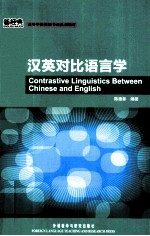

汉英对比语言学PDF电子书下载
- 电子书积分:13 积分如何计算积分?
- 作 者:陈德彰著
- 出 版 社:北京:外语教学与研究出版社
- 出版年份:2011
- ISBN:9787513512916
- 页数:354 页
Chapter 1 Language and Thinking 1
1.1 Introduction 1
1.1.1 Definition of language 1
1.1.2 Characteristics of language 3
1.2 Comparison of English and Chinese 3
1.2.1 Reason for contrastive studies between English and Chinese 3
1.2.2 A preliminary comparison 4
Chapter 2 Words and Characters 20
2.1 English letters and Chinese characters 20
2.2 Development of Chinese characters 26
2.3 The relation between Chinese characters and words 31
2.4 Motivation of words 41
2.5 Meaning of words 45
2.6 Word as a unit 56
Chapter 3 Primal Words and Secondary Words 59
3.1 Introduction 59
3.2 Formation of secondary words 60
3.2.1 Combining 61
3.2.2 Examples of a special type of derivation 61
3.2.3 Compounding 74
3.3 Shortening 76
3.3.1 Acronym 76
3.3.2 Blending 78
3.3.3 Clipping 81
3.3.4 Shortening of Chinese words 82
3.4 Other means of new word formation 87
3.4.1 Conversion 87
3.4.2 Borrowing 88
3.5 Analogy 97
Chapter 4 Intonation and Tone 101
4.1 Intonation 101
4.2 Syllable 103
4.3 Sound effect of poems 109
Chapter 5 Conception and Nomenclature 114
5.1 Lexical disparity 114
5.2 Lexeme gap 115
5.2.1 Different motivations behind nomenclature 115
5.2.2 Different ways of grouping things 120
5.2.3 Differences among synonyms 124
5.2.4 Things unique to a culture 126
5.3 Semantic gap 128
5.3.1 Different reference meanings 128
5.3.2 Different extended meanings 134
5.3.3 Different directions of meanings 135
5.4 Usage Gaps 137
5.4.1 Transitivity 137
5.4.2 Differences caused by word formation 139
5.4.3 Differences caused by flexible usage—conversion 140
5.4.4 Differences caused by different grammatical meanings between corresponding words 141
Chapter 6 Abstraction and Concretion 147
6.1 Abstraction and abstract meaning 147
6.2 杯as an example 150
6.3 Further abstraction 159
6.4 Abstraction and sentence structure 165
6.5 Concretization of abstract nouns 168
Chapter 7 Stativeness and Dynamicity 174
7.1 Introduction 174
7.2 The verb 175
7.2.1 Functions of verbs 176
7.2.2 Classification of verbs 177
7.2.3 Morphological changes of English verbs 181
7.2.4 The use of verbs in the sentences 182
7.3 Verbalization of nouns 185
7.4 Action or motion implied in other parts of speech 192
7.4.1 The noun 192
7.4.2 Other parts of speech 201
7.5 At the syntactic level 204
Chapter 8 Overtness and Covertness 212
8.1 Markers 212
8.2 Parts of speech and their function in the sentence 214
8.3 The article 222
8.4 Marker of the plural 231
8.5 Chinese auxiliaries的,地,and得 238
8.5.1 的 238
8.5.2 地 241
8.5.3 得 242
8.6 The passive 246
8.7 Punctuation marks 248
Chapter 9 Rigidity and Flexibility 251
9.1 General difference between Chinese and English grammar 251
9.2 Definition of the sentence 252
9.3 Classification of sentences 256
9.3.1 Some special Chinese sentence patterns 267
9.4 Elements of the sentence 273
9.4.1 The subject 273
9.4.2 Relation between the verb and its object 285
9.5 Word order 292
9.5.1 Adverbials 296
9.5.2 Relative clauses 302
9.5.3 Inversion 304
9.6 Parataxis and hypotaxis 309
9.6.1 Connectives 310
Chapter 10 Objectivity and Subjectivity 330
10.1 Language and subject 330
10.2 Daily usage of the language 333
10.3 Subjective and objective standards 335
10.4 Depiction of mental activities in English 338
10.5 The passive voice 341
10.6 Animated and inanimate subjects 343
10.7 Different levels of objectivity 345
Bibliography 349
Recommended Readings 351
- 《程序逻辑及C语言编程》卢卫中,杨丽芳主编 2019
- 《幼儿园课程资源丛书 幼儿园语言教育资源》周兢编 2015
- 《高等学校“十三五”规划教材 C语言程序设计》翟玉峰责任编辑;(中国)李聪,曾志华,江伟 2019
- 《音乐语言的根基》张艺编著 2019
- 《英汉轻动词对比研究》朱乐奇著 2019
- 《认知语言学视野的抽象方位结构研究》曹爽著 2019
- 《激活语言思维》李蒨,王宏年,汤青编著 2017
- 《汉语言文学本科专业核心课程研究导引教材 古代汉语》马蓝婕责任编辑;(中国)魏宜辉 2019
- 《国内外辐射环境监测体系对比研究》上海市辐射环境监督站 2019
- 《英语教师语言意识研究》秦莉,赵春贺著 2019
